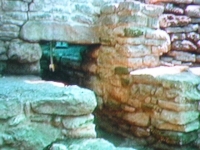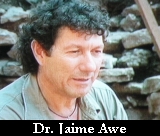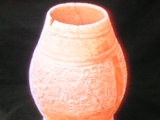| As we told you yesterday, it's Archeology Week, and to honor the occasion we went into our archives form 12 years ago to look at a most unusual archeological find. IT's like a pre historic sauna out at Pook's Hill outside Teakettle Village. Here's that story from our Archive:...

Jules Vasquez Reporting, [jules.vasques@gmail.com]
Sitting about half an hour away from Teakettle on a rough road that cuts right
through the rainforest - we came upon Pook's Hill - a bustling hive of archaeological
activity. 15 international archaeology students are here excavating the site:
breaking stone, making copious maps of the layout, and clearing away one thousand
years of overgrowth brick by brick.
Leading the dig is University of London student Christophe Helmke. It's part
of the Belize Valley Archeological Reconnaissance Project - a homegrown project
directed by Dr. Jaime Awe. Along with Dr. John Morris and NICH President Yasser
Musa, Awe explained that Pook's Hill, though a very small site, is very important
to understanding how the Maya lived.
Dr. Jaime Awe,
"Pook's Hill is a relatively small site. I mean this does not compare
in anyway to Cahal Pech and Caracol; this would be a very small plaza at Caracol.
But despite its size, this site is incredibly important because it provides
us with some new information on certain types of activities that have previously
never been recorded for Belize."
And foremost among those is a sweat bath. It's comparable to what we know today
as a sauna. This structure now being mapped and detailed by students - may not
look like much from outside - not much more than a very low doorway - but it
is no less than a revelation.
Dr. Jaime Awe,
"Right up to 1996 no sweat bath had ever been recorded for the country
of Belize, or indeed for the eastern Maya lowlands. This sweat bath at Pook's
Hill represents the first of its kind in this part of the Mayan World."
But what sets this sweat bath apart from any other ever discovered in the Maya
world is the architecture.
Dr. Jaime Awe,
"There is a very small entrance into this small chamber and the chamber
is accessed by a series of steps that goes up to what we call a bench and then  above that the roof of the structure is domed. The room is also circular. Like
I said many sweat baths that have been found before do not have this shape.
Many of them are rectangular or even squared and some of them are circular.
But this one is domed and it is domed in such a way that the Maya were using
the technique for vaulting that we find at major sites. So there again very
interesting. above that the roof of the structure is domed. The room is also circular. Like
I said many sweat baths that have been found before do not have this shape.
Many of them are rectangular or even squared and some of them are circular.
But this one is domed and it is domed in such a way that the Maya were using
the technique for vaulting that we find at major sites. So there again very
interesting.
Domed structures, or domed arches if you want, are incredibly unusual for
the Maya. In fact we know the Maya never used the true arch, they used the corbel
vault and that forced them to have very long narrow rooms. Well the domed arch
is even more rare because not only we don't the true arches in the Maya region,
but this domed arch meant that they had to work it in such a way that it was
vaulted on all sides. It was a very precarious type of architecture and yet
they managed to do it here at Pook's Hill. And like I said, this is the only
example of a domed arch that I know of."
And so what happened under this domed arch?
Dr. Jaime Awe,
"The technology that they use is that they have these very small rooms.
We are standing out here and we're sweating so imagine if you go into this little
chamber which has a doorway that's not even three feet high and about a 1 foot
and a half wide and these benches and are high so there's not much space in
there. But they build the benches high enough that you are nearly touching the
roof. Then they build a fire where they have stones and those stones start to
heat up and you throw water and there's steam. What happens to heat is it rises.
You're sitting up on those high benches and man you'll be hot and sweating in
no time giving the technology that they are using. And the dome keeps the heat
trapped.
We know that sometimes when people have fevers etc they would be brought
in and made to sweat so they could get rid of or release some of the diseases
that they had. We also know that women, either during childbirth or after childbirth,
were often brought into the pibmah and again had a steam bath, again to cleanse
them.
People would go into them and they would beat each other's back with branches.
And by doing that, it would open the pores so that you sweat some more so part
of it was just to get rid of whatever things that are bad in your body. We do
that sometimes."
And when the Mayans abandoned the site in the Terminal Classic Period, in about
950 AD, they left the sweat bath full of shards of their pottery.
Dr. Jaime Awe,
"When the Mayas abandoned here it looks like they smashed a lot of offerings
at the entrance and even on top of the steps of this little chamber. Many of
those objects include things like figurines like whistles which are musical
instruments and beautifully carved vases which we will see in a little while."
That vase that Awe refers to is this  painstakingly reconstructed vessel. It
is one of the best preserved vessels of its kind in Belize and is notable because
it blends styles common in Mayan and Mexican art of the Terminal Classic period
- which is about a thousand years ago. painstakingly reconstructed vessel. It
is one of the best preserved vessels of its kind in Belize and is notable because
it blends styles common in Mayan and Mexican art of the Terminal Classic period
- which is about a thousand years ago.
And while this vase links Pook's Hill to Mexico, perhaps the most exciting
linkage is the one to the nearby Actun Tunich Hill Mucknal Cave where many human
sacrifices and burials are preserved.
Dr. Jaime Awe,
"The people who live at these little places are the people who are going
to Tunich Hil into those caves and so the same type of artifacts we are finding
the caves, we are finding in here, suggesting perhaps that the people who are
living on these sites like Pook's Hill are producing this pottery and taking
them into the caves."
Jules Vasquez,
Are the skeletal remains that you found in those caves, may have been from places
like this which are adjacent?
Dr. Jaime Awe,
"Certainly. We find a lot of skeletons from people that were sacrificed
in the caves. It is possible that some of those people came from places like
this. In fact one of the future things we want to do is do some DNA analysis
of the teeth from some of the 'victims' in the cave and then do some analysis
of the teeth from the burials we find at sites like Pook's Hill and compare
them and see if there is a match. Wouldn't that be wonderful?"
An exciting prospect that continues to show the vast interconnected nature
of the Maya sites in Belize.
Fast forward to this week in 2017, and the Institute of Archaeology is observing the week with a touring lecture series hosted today and tomorrow in Orange Walk Town.
The team will next visit San Pedro Town, on Thursday and Friday.
7NEWS
produced for broadcast by News Director Jules
Vasquez
Edited and Prepared for the internet by Keith
Swift
| 
